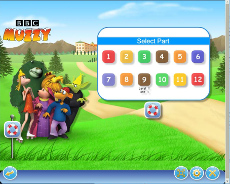MUZZY® is an online program for learning foreign languages produced by the BBC. The parent or teacher need not know the language to be learned.
The target audience is PreK up through about eighth grade. Muzzy, the character for which the program is named, is a large, green, furry creature who eats clocks. The King and Queen of Gondoland, Princess Sylvia, and other characters are featured in a storyline that runs through the program. Homeschoolers can choose full courses from either Latin American Spanish or French, and I selected Spanish for my review.
There are also less comprehensive courses in other languages available to homeschoolers under the “For Families” tab on the website. These courses lack the lesson plans and reproducible files for activity pages, assessments, flashcards, and images, and a few other resources that come with the comprehensive full courses for homeschoolers. The other languages that are taught in these less-comprehensive courses are Mandarin Chinese, German, Italian, English, and Korean. For those without an internet connection, there is a Curriculum Binder and DVD set for either Spanish or French that contains most of the course material. You will be missing the online interactive games and the teacher’s dashboard, but you will have printable materials for the course itself. You can also get a set of six DVDs for any of the languages along with one year of online access. These DVD sets have all of the online animated stories but do not include the binder.
The program teaches by direct instruction as well as immersion, using animated stories, interactive activities, songs, games, and printable resources. Segments with a character named Norman are used to teach vocabulary in a format outside of the Gondoland storyline. Note that learning activities are sometimes referred to as games, although they do not really have the competitive elements of games.
You might want to print out the Guide to Parents which explains how to use the program, but you can also click on the image of the lifesaving ring on the home page for each level to bring up an explanation.
You can use whichever aspects of the program work for your child, so it is very adaptable. A pre-reader can simply listen and interact with a few of the activities while older children can complete activities that require reading and spelling skills.
Animated stories are presented entirely in the selected language, although users can select subtitles shown in either English or the selected language for the study. The program has twelve levels. The first level presents simple vocabulary within the context of the story. It often jumps off the storyline to provide instruction on particular words or concepts. By the twelfth level, children will have been exposed to more than 1,200 words or phrases.
Stories and other lessons are accompanied by a number of activities online plus printable resources. Online activities include matching games for students to identify images with the correct words, phrases, or sentences; fill-in-the-blanks exercises; audio flashcards for review; and other activities such as feeding the correct number of clocks to Muzzy as a number matching exercise. A listen-and-record exercise has students practice repeating phrases into a microphone. (You can skip this if you don't have a mic.)
Printable pages are illustrated in either full color or black and white. Some printable resources are available on the screen showing lesson components for each level, but more are accessible through the teacher dashboard. The teacher dashboard is usually the best way to find all of the content available to you. There you will find lesson plans with answer keys, student activity sheets, cultural lessons (about the country or countries where the language is spoken, student assessment sheets, The Big Muzzy Story, the Video Story Book (the transcript of the video lessons), flashcards, vocabulary books, songs (either with words or only instruments), and more.
The teacher dashboard has sophisticated search features that allow you to find exactly the content you want. For example, you can select for readers, non-readers, or “mixed.” You can choose the level of difficulty. You can also select types of activities or search for key words on particular topics. While it works great most of the time, I occasionally got no results when it looked like I had properly selected for something such as The Big Muzzy Story.
Since the program uses an immersion approach, children will be exposed to much more vocabulary than you should expect them to learn. They should listen to the lessons a number of times to absorb the language as best they can. Activities help children to master particular vocabulary words and phrases that are appropriate for beginners rather than holding them accountable for all that they hear. This gives children the opportunity to feel successful with their accomplishments in learning basic vocabulary while laying the foundation for future study.








